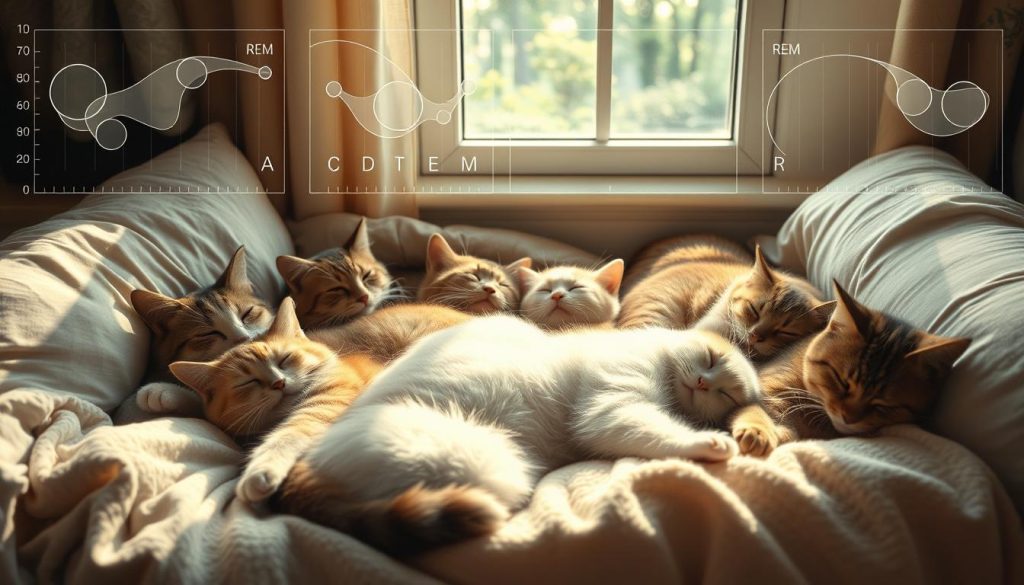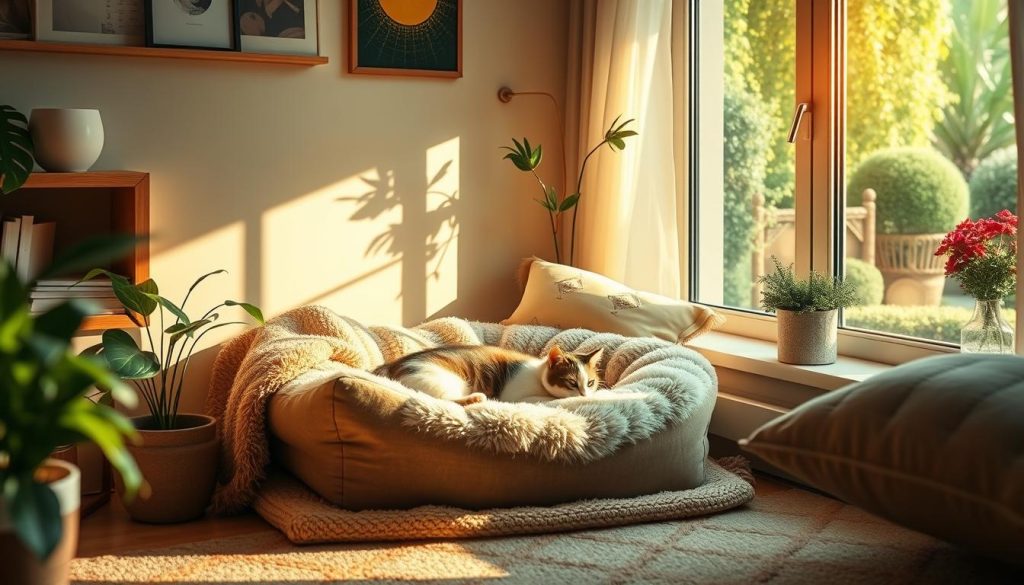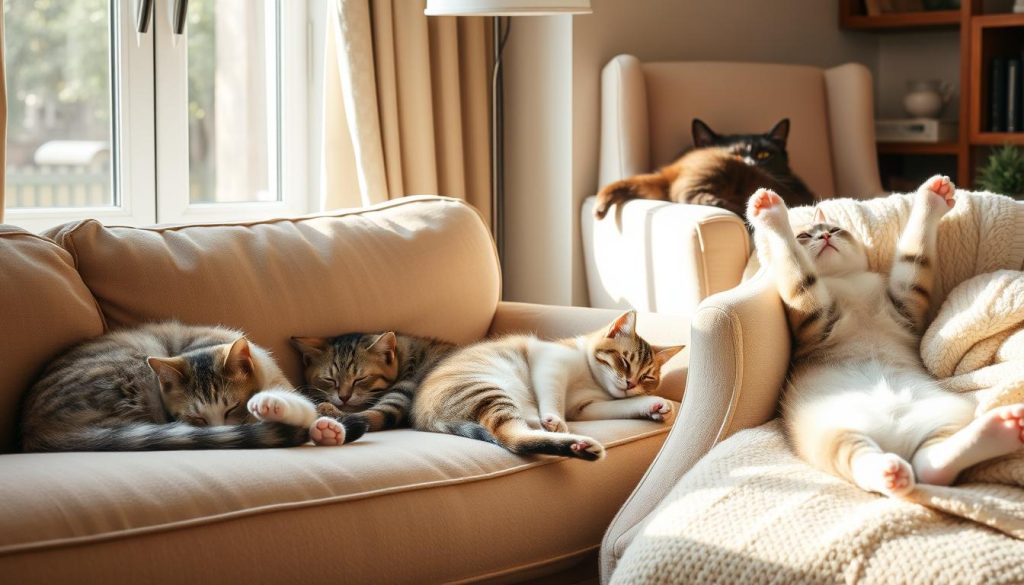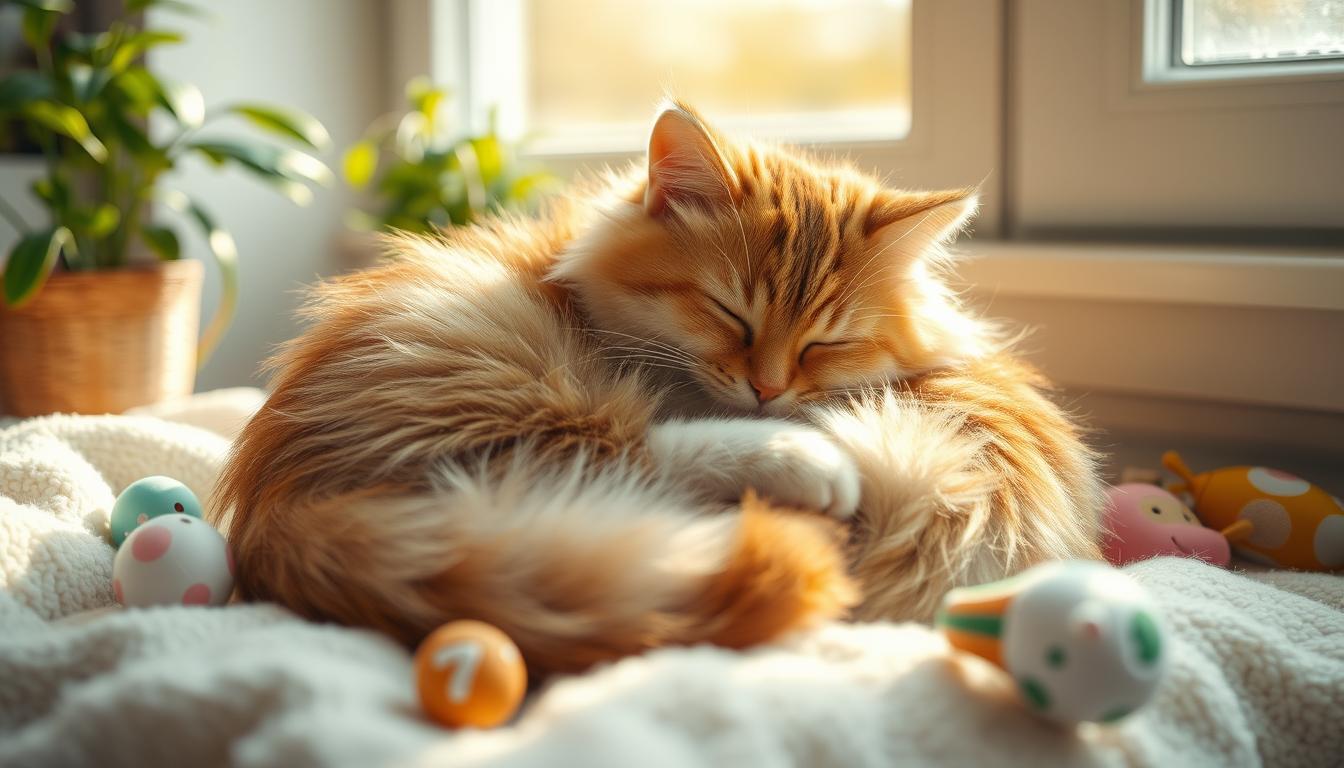As a devoted cat enthusiast, I’ve always been fascinated by their sleeping patterns. From waking up to late at night, I watch my furry friends sleep. I wonder what secrets they keep while they nap.
In this article, we’ll explore the mysteries of cat sleeping habits. We’ll look into the science behind their love for sleep. It’s a journey to understand their unique napping world.
If you’re a cat owner or just curious, you’re in for a treat. We’ll talk about the difference between catnaps and deep sleep. We’ll see how age and breed affect their sleep.
We’ll also find out why cats love to nap so much. By the end, you’ll appreciate your cat’s sleep patterns more. You’ll know how to make their sleep space perfect.
Understanding the Unique Sleeping Patterns of Felines
Cats have fascinating sleeping habits that make them stand out. They are not just lazy loungers. Their sleep patterns are complex and purposeful.
Exploring the Differences Between Catnaps and Deep Sleep
Cats love to take short naps, called “catnaps,” during the day. These naps last from a few minutes to an hour. They help cats stay alert and conserve energy.
At night, cats enter deeper sleep cycles. Their brain and heart slow down. This deep sleep helps them recharge and feel refreshed.
The Role of Age and Breed in Shaping Sleeping Habits
A cat’s sleep time changes with age and breed. Kittens sleep more because their bodies grow fast. They need lots of rest.
Some breeds, like the Ragdoll or Siamese, sleep differently. Their natural energy and mood influence their sleep patterns.
Learning about cat sleep cycles helps us understand our feline friends better. It also shows how to create the best sleep space for them.
Cat sleeping habits: A Peek into Their Mysterious World
Cats are fascinating creatures, and their sleeping behaviors are no exception. As feline enthusiasts, we’re often captivated by the mysterious rituals and patterns that govern their nap times. Understanding their sleeping habits gives us a unique glimpse into their world.
One of the most intriguing aspects of cat sleeping behaviors is the role of their hunting instincts. Cats are crepuscular animals, meaning they are most active at dawn and dusk, the prime times for hunting. This natural predisposition heavily influences their sleep-wake cycles, with cats often sleeping during the day and becoming more alert and active in the early morning and late evening hours.
Interestingly, the sleeping patterns of cats can also vary depending on their age and breed. Kittens, for instance, tend to sleep more than adult cats, often catching up to 20 hours of shut-eye per day. On the other hand, older cats may exhibit more fragmented sleep, waking up more frequently throughout the day and night. Certain breeds, such as Siamese and Ragdoll cats, are known to be more active and have slightly different sleep-wake rhythms compared to other feline companions.
| Breed | Average Sleep Duration | Sleeping Patterns |
|---|---|---|
| Domestic Shorthair | 12-16 hours | Polyphasic (multiple short naps throughout the day) |
| Siamese | 10-14 hours | Biphasic (two longer sleep periods, one during the day and one at night) |
| Maine Coon | 14-18 hours | Monophasic (one long sleep period, typically at night) |
By delving into the feline sleep mystery, we can gain a deeper understanding of our furry companions and their unique behaviors. From the way they curl up in cozy spots to the twitches and meows that accompany their nap times, there’s always something new to discover about the sleeping habits of our beloved cats.
The Fascinating Science Behind Cat Napping

Cats are famous for sleeping a lot. But have you ever thought about what’s happening when they nap? The science of cat sleep is really interesting. It explains why they sleep so much.
How Much Sleep Do Cats Really Need?
Cats sleep about 15 hours a day. They also spend time awake, grooming, and doing other things. The amount of sleep a cat needs can change. It depends on their age, breed, and personality.
Kittens sleep up to 20 hours a day. Senior cats might sleep a bit less. Cats sleep in cycles, with light and deep sleep. This helps them stay alert and ready to hunt.
| Age | Average Sleep Duration |
|---|---|
| Kittens | 20 hours per day |
| Adult Cats | 15 hours per day |
| Senior Cats | 12-16 hours per day |
The science of cat sleep is fascinating. It shows that cats need a lot of time to rest and get their energy back. Knowing this can help pet owners make a great sleep space for their cats.
Creating the Purrfect Sleeping Environment

As a devoted cat parent, I know how important a comfy sleeping spot is for our feline friends. Cats nap a lot, so we need to make their sleep areas just right. This supports their unique sleep needs.
For the perfect cat sleep spot, consider a few things. The temperature and lighting should be just right. Cats like it cooler, around 70-80°F (21-27°C). They also prefer dim or dark places to sleep.
It’s key to offer different soft bedding options. Cats enjoy burrowing and nesting. So, having cushy beds, fluffy blankets, and even cardboard boxes can make them feel secure and comfy.
- Soft, cozy beds or cushions
- Warm, plush blankets or throws
- Cardboard boxes or paper bags for burrowing
Also, creating “hiding spots” in the sleeping area is important. Elevated perches, cat trees, or cozy spots under furniture are great. They give your cat a safe place to rest and recharge.
| Feature | Recommendation |
|---|---|
| Temperature | 70-80°F (21-27°C) |
| Lighting | Dim or darkened |
| Bedding | Soft, plush, and cozy |
| Hiding spots | Elevated perches, cat trees, or nooks |
By thinking about these elements and creating a cozy sleep area, you can help your cat sleep well. A well-rested cat is a happy cat!
Decoding Your Cat’s Sleep Positions and Behaviors

As cat owners, we often find ourselves captivated by the mysterious ways our feline friends slumber. But did you know that the positions and behaviors they exhibit while sleeping can reveal a lot about their physical and mental well-being? Let’s dive in and decipher the hidden meanings behind your cat’s sleeping habits.
What Do Those Twitches and Meows Mean?
Cats are masters of communication, and their sleeping positions and behaviors can provide valuable insights into their inner workings. From the well-known “loaf” position to the more curious “sphinx” pose, each sleep posture carries a unique significance. Twitching paws and meowing during sleep may indicate your cat is experiencing a vivid dream, while a curled-up ball suggests a desire for warmth and security.
Understanding cat sleep positions and interpreting cat sleep behaviors can help you better understand cat sleep signals and cater to your furry companion’s needs. By observing and learning the nuances of your cat’s sleeping patterns, you can gain a deeper appreciation for their unique personalities and preferences.
Whether your cat is snoozing in a cozy nook or sprawled out in the sunlight, each slumbering moment offers a glimpse into their world. By decoding these sleep signals, you can tailor your cat’s environment and care to ensure they enjoy a tranquil, rejuvenating rest, setting the stage for a happy, healthy feline friend.
Addressing Common Sleep-Related Issues in Cats
As devoted cat owners, we often find ourselves puzzled by our feline friends’ sleeping behaviors. Cats generally love to snooze, but sometimes they face sleep-related issues. These issues can impact their health and well-being.
In this section, we’ll explore common sleep-related problems in cats. This includes insomnia, night waking, and sleep disturbances. We’ll discuss strategies to address these concerns. Understanding the causes and implementing effective solutions can help our cats get the quality rest they need.
Addressing Cat Sleep Problems
One common sleep issue in cats is insomnia. They struggle to fall or stay asleep. This can be due to stress, anxiety, or discomfort. To help, create a calming environment and provide soothing distractions. Also, consult with your veterinarian to rule out any medical conditions.
Another issue is night waking, where cats become active and vocalize at night. This can be caused by boredom, hunger, or a shift in their sleep-wake cycle. To address this, establish a consistent feeding and playtime routine. Provide engaging toys and activities to keep them occupied.
| Sleep-Related Issue | Potential Causes | Suggested Solutions |
|---|---|---|
| Insomnia | Stress, anxiety, discomfort | Create a calming environment, provide soothing distractions, consult a veterinarian |
| Night Waking | Boredom, hunger, shifted sleep-wake cycle | Implement a consistent feeding and playtime routine, provide engaging toys and activities |
| Sleep Disturbances | Chronic pain, cognitive decline, environmental factors | Address any underlying medical conditions, adjust the sleeping environment, consult a veterinarian |
Cats may also face sleep disturbances due to chronic pain, cognitive decline, or environmental factors. To address these, address any underlying medical conditions and adjust their sleeping environment. Seeking guidance from a veterinarian can also help.
By understanding and addressing cat sleep problems, we can support our feline companions. This ensures they get the restful sleep needed for their health and well-being. Remember, every cat is unique. It may take some trial and error to find the best solutions for feline sleep issues.
Myths and Facts About Cats and Their Sleep Cycles
Many people think cats sleep a lot, but there’s more to it. As a cat owner, I’ve learned to sort out what’s true and what’s not. This helps me take better care of my cat and understand them better.
One common myth is that cats sleep all day. While they do nap a lot, they go through different sleep stages. They can be very active at dawn and dusk, when they feel like hunting.
Another myth is that older cats sleep more. But, sleep patterns can change for any cat, no matter their age or breed. Health, environment, and personal preference all affect how much a cat sleeps.

